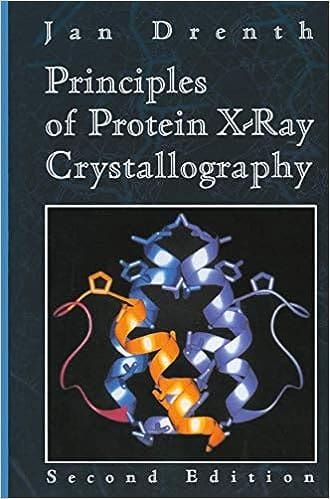Principles of Protein X-ray Crystallography

Featured Resource: Dive Deeper into Protein X-Ray Crystallography
For those of you who are captivated by the intricacies of protein structures and wish to deepen your understanding, we highly recommend “Principles of Protein X-ray Crystallography” by Jan Drenth.
This comprehensive guide is an excellent resource, providing detailed insights into the principles and applications of protein X-ray diffraction. Whether you’re a budding scientist, an experienced researcher, or a curious reader, this book will serve as a valuable companion on your journey to understanding the remarkable world of protein structures.
In “Principles of Protein X-ray Crystallography”, you’ll find a wealth of information, from basic principles to advanced techniques, that will enrich your knowledge and inspire your curiosity.
Don’t miss out on this opportunity to explore this fascinating field in depth. Click here to get your copy of “Principles of Protein X-ray Crystallography” on Amazon today and embark on an enlightening journey into the world of protein X-ray diffraction!
I. Introduction
Understanding the intricate world of proteins is a fascinating journey, one that’s greatly aided by the technology of X-ray diffraction. This powerful technique has revolutionized the ways we comprehend the structure and function of proteins, opening up new frontiers in various fields including biochemistry, medicine, and pharmacology. In this blog post, we will delve deep into the world of X-ray diffraction of proteins, highlighting the benefits it offers and the problems it helps us solve.
II. Background Information
X-ray diffraction is a method employed to determine the arrangement of atoms within a crystal, in this case, a protein crystal. First discovered in the early 20th century, the technique has since become a cornerstone in determining protein structures. Proteins, the workhorse molecules of life, perform a plethora of functions in biological systems – from catalyzing biochemical reactions to providing structural support. Understanding their structures is crucial to unraveling their function, and by extension, the mystery of life itself.
III. The Process of X-Ray Diffraction
The process of X-ray diffraction starts with the crystallization of proteins, a challenging yet crucial step. Once a protein crystal is obtained, it is bombarded with a beam of X-rays. The X-rays are diffracted by the electron cloud of each atom in the protein crystal, leading to a diffraction pattern that is captured on a detector. This diffraction pattern is then interpreted to elucidate the protein’s three-dimensional structure.
IV. Application of X-Ray Diffraction in Protein Structure Determination
X-ray diffraction has played a pivotal role in our understanding of protein structures. It has unveiled the structures of numerous proteins, providing insights into their function and mechanism of action. For instance, the structure of hemoglobin, the oxygen-carrying protein in our blood, was determined using X-ray diffraction. This revelation helped scientists understand how hemoglobin binds to oxygen and releases it where needed.
V. Problems Solved by Understanding Protein Structures through X-Ray Diffraction
The knowledge of protein structures has far-reaching implications. In medicine, it creates pathways for the development of novel therapeutics. By understanding the structure of a protein associated with a disease, scientists can design drugs that can modulate the protein’s function, thereby treating the disease. Furthermore, it aids in understanding the mechanisms underlying various diseases. For instance, the structural knowledge of proteins misfolded in neurodegenerative diseases like Alzheimer’s has shed light on the disease’s progression.
VI. Resources and Tools for Studying X-Ray Diffraction of Proteins
There are a multitude of resources available for those interested in exploring X-ray diffraction of proteins. For a deeper understanding, you can refer to the following books available on Amazon:
- “Introduction to Protein Structure” by Carl Branden and John Tooze offers an excellent starting point.
- For more advanced readers, “Protein Crystallography: Methods and Protocols” by Alexander Wlodawer et al. provides a detailed guide to protein crystallography methods.
VII. Conclusion
The study of protein structures through X-ray diffraction equips us with the knowledge to tackle various challenges in healthcare and biology. It is a field that continues to grow and evolve, offering exciting opportunities for discovery and innovation.
VIII. Call to Action
If you found this guide insightful, please share it with others who might be interested. We’d love to hear your thoughts, questions, or experiences with X-ray diffraction of proteins in the comments section below. Let’s continue this enlightening journey into the world of proteins together!
Other Articles
We appreciate your time in reading our blog post, “X-Ray Diffraction of Proteins: A Comprehensive Guide”. We hope you found the information valuable. If you’ve enjoyed this piece, we encourage you to explore more posts on sunnydaysgo.com that may pique your interest. Your sharing of our content is greatly appreciated as it helps us and our community grow. Below are five articles that might intrigue you:
- Rosalind Franklin and X-ray Diffraction: Unveiling the Structure of Life
- The Science of Skincare: Understanding Collagen and Elastin
- How Not To Die: Discover How To Prolong It Now!
- The Building Blocks of Life: Understanding DNA Structure
- The Magic of Minerals: A Dive into Mineralogy
Thank you for your support!
